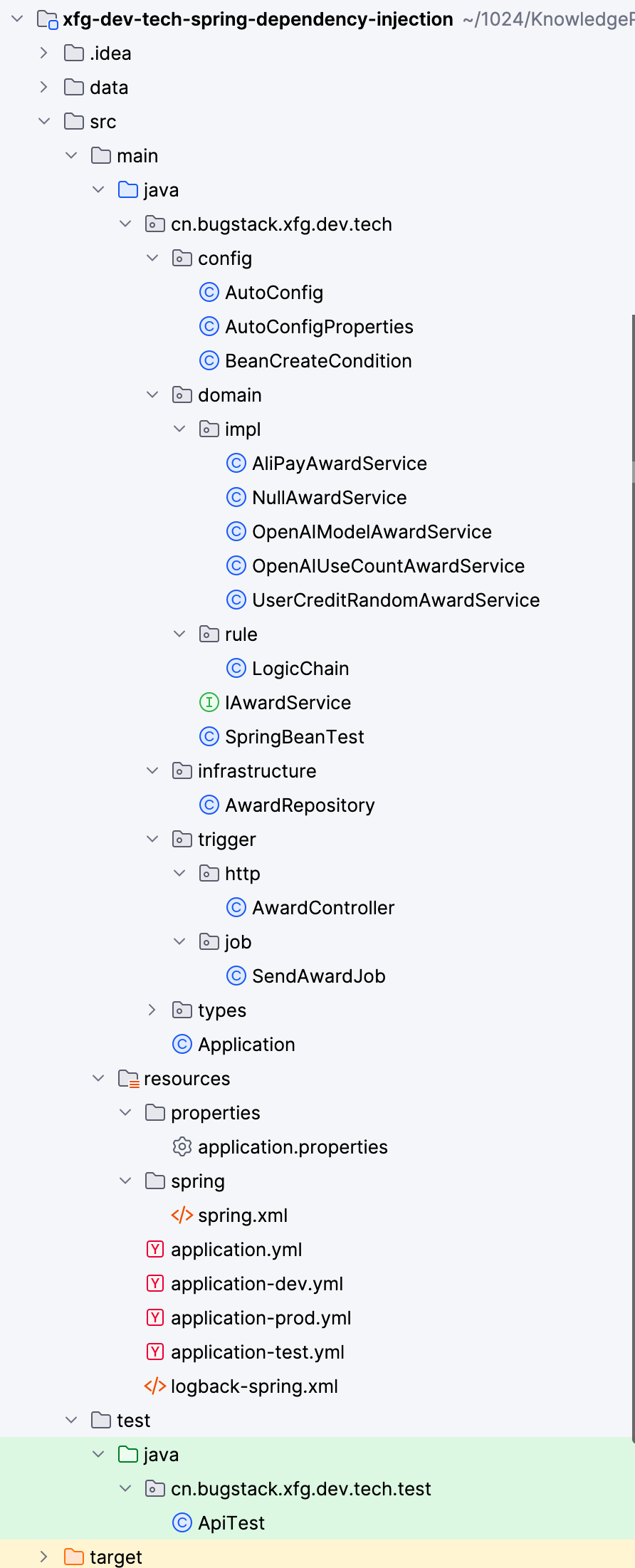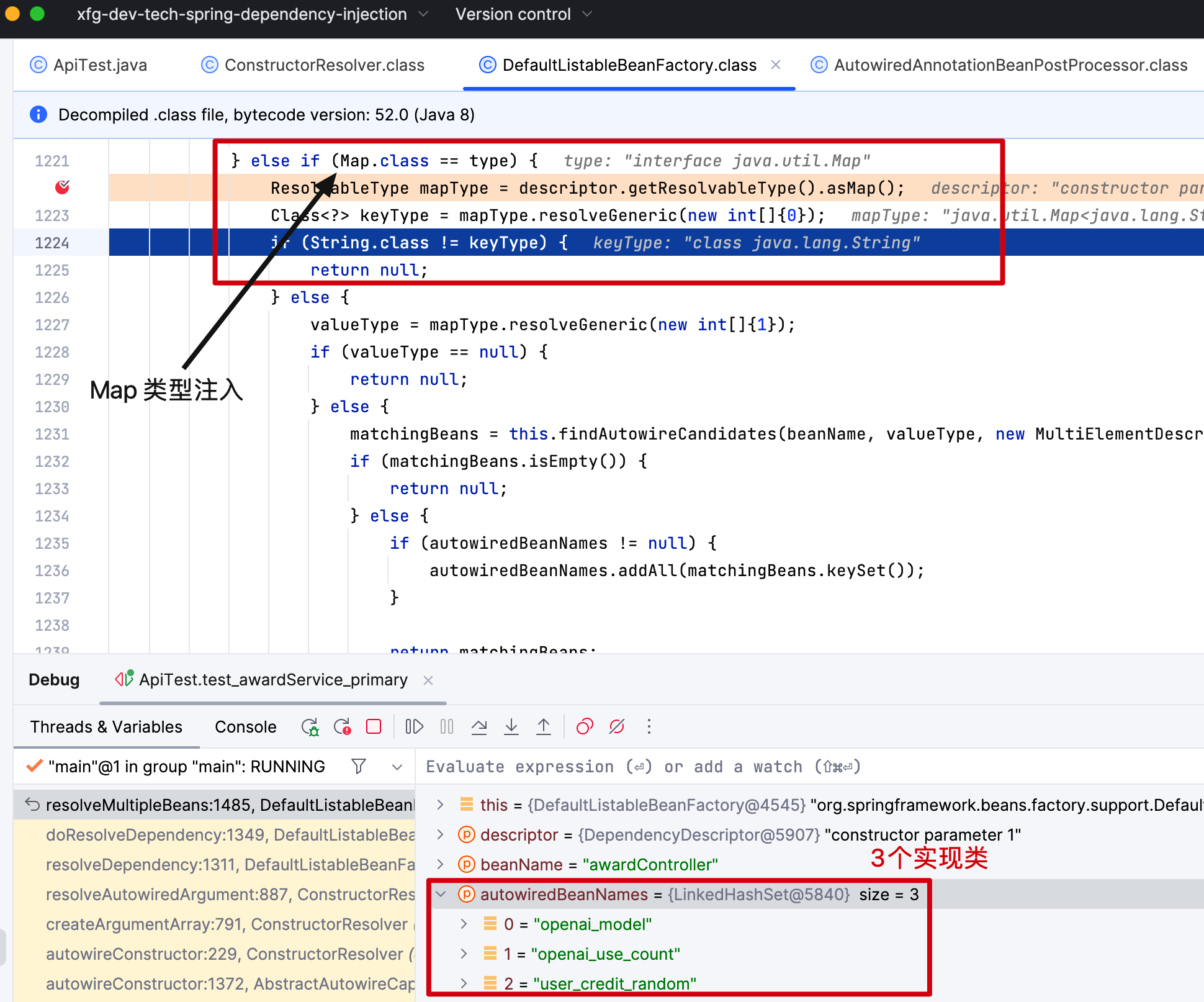# Spring Dependency Injection - 依赖注入使用技巧
作者:小傅哥
博客:https://bugstack.cn (opens new window)
沉淀、分享、成长,让自己和他人都能有所收获!😄
大家好,我是技术UP主小傅哥。
@Autowired 注入会用,@Resource 注入知道,但在项目看到一个没使用这2个注解的,直接在构造函数写了个两个入参 public AwardController(List<IAwardService> awardServices, Map<String, IAwardService> awardServiceMap) { ... 就不知道是怎么注入的了。我猜可能是以前一直写 CRUD 流水席代码,导致 Spring 的一些高级注入特性从来没接触过。所以小傅哥今天来给大家专门总结下 Spring 的各种注入的使用,方便小伙伴们可以运用这些特性,写出优雅的代码。

你可以不用,但不能不会!
在小傅哥带着大家做的实战项目中「 https://gaga.plus (opens new window) 」,有着大量的高级编程技巧和设计模式结合运用的手段,帮你打开能”拿捏“写代码的强悍能力。这些能力都是越早积累越好,否则你以为,为啥一边有人喊着寒冬,一边有人拿着高薪。
文末提供了整合案例源码,以及5个业务应用级项目,5个技术组件项目。🛫
# 一、工程说明
为了让大家更好的理解和学习 Spring 各类依赖注入的相关使用,这里小傅哥专门提供了案例工程,把相关的注入特性都整合进去。学习中可以下载工程对照验证。

- config:工程所需的配置类对象的使用案例。
- domain:一个接口多个实现类、实现类优先级创建、原型对象、Spring 加载的对象。
- infrastructure:仓储注解实例化对象的使用。
- trigger:list注入、map注入、依赖注入,对象初始和销毁的监听。
- ApiTest:测试各类注入案例的验证。
# 二、实践案例
实例化注解:
@Component:组件注解@Service:服务注解@Repository:仓储注解,提供对持久化类数据的操作的服务。@Controller/@RestController():对外提供服务的注解。
# 1. 构造注入&List、Map
private final List<IAwardService> awardServices;
private final Map<String, IAwardService> awardServiceMap;
public AwardController(List<IAwardService> awardServices, Map<String, IAwardService> awardServiceMap) {
this.awardServices = awardServices;
this.awardServiceMap = awardServiceMap;
}
public Response<String> distributeAward(@RequestParam String userId, @RequestParam String awardKey) {
try {
log.info("发放奖品服务 userId:{} awardKey:{}", userId, awardKey);
awardServiceMap.get(awardKey);
return Response.<String>builder()
.code("0000")
.info("调用成功")
.data("发奖完成")
.build();
} catch (Exception e) {
return Response.<String>builder()
.code("0001")
.info("调用失败")
.build();
}
}
2
3
4
5
6
7
8
9
10
11
12
13
14
15
16
17
18
19
20
21
22
23
24
- 场景:IAwardService 接口有多个实现类,可以通过 @Resource、@Autowired 注解注入,也可以通过构造函数注入。在 Spring 官网文档中,是推荐使用构造函数注入的:
The Spring team generally advocates constructor injection, as it lets you implement application components as immutable objects and ensures that required dependencies are not null.https://docs.spring.io/spring-framework/reference/core/beans/dependencies/factory-collaborators.html (opens new window) - 用途:Map 注入是一个非常好的注入手段,我们可以把每个 IAwardService 实现类设定好 Bean 的名称为数据库中的奖品 awardKey。在发奖的时候,可以直接根据 awardKey 从 Map 中获取到对应的 Bean 对象,这样也就省去了
if···else大量的判断操作。
# 2. 空注入判断
public class NullAwardService implements IAwardService {
@Override
public void doDistributeAward(String userId) {
}
}
@Autowired(required = false)
private NullAwardService nullAwardService;
2
3
4
5
6
7
8
9
10
11
- 场景:NullAwardService 没有配置 @Service 注册,或者在程序中手动实例化的这个 Bean 对象,根据不同诉求,在没有创建的时候。可以使用
@Autowired(required = false)进行注入。这样就不会报错 nullAwardService 空指针异常。 - 用途:当我们在使用支付、openai外部接口对接测试阶段,可能有些时候是需要关闭服务的,也就是不实例化对象。那么这个时候就配置
@Autowired(required = false)避免注入空指针
# 3. 优先实例化
@Slf4j
@Service("openai_model")
// Primary 首选 Bean 对象标记
@Primary
@Order(1)
public class OpenAIModelAwardService implements IAwardService {
@Override
public void doDistributeAward(String userId) {
log.info("发奖服务,OpenAI 模型奖励 {}", userId);
}
}
@Resource
private IAwardService awardService;
@Test
public void test_awardService_primary() {
log.info("测试结果 {}", awardService.getClass());
}
// 测试结果 class cn.bugstack.xfg.dev.tech.domain.impl.OpenAIModelAwardService
2
3
4
5
6
7
8
9
10
11
12
13
14
15
16
17
18
19
20
21
22
23
- 场景:一个 IAwardService 有多个实现类的时候,如果还想用
@Resource 注入 awardService的时候是会报错说NoUniqueBeanDefinitionException异常了。这个时候使用 @Primary 就会标记为首选对象,注入的时候会注入这个对象。另外这里的@Order(1)是对象的加载顺序。 - 用途:当我们为一组接口提供实现类,并需要提供默认的注入的时候,就可以使用
@Primary注解来限定首选注入项。
# 4. 检测创建,避免重复
@Bean("redisson01")
// 当 Spring 应用上下文中不存在某个特定类型的 Bean 时,才会创建和配置标注了 @ConditionalOnMissingBean 的 Bean 对象
@ConditionalOnMissingBean
public String redisson01() {
return "模拟的 Redis 客户端 01";
}
@Bean("redisson02")
// 当 Spring 应用上下文中不存在某个特定类型的 Bean 时,才会创建和配置标注了 @ConditionalOnMissingBean 的 Bean 对象
@ConditionalOnMissingBean
public String redisson02() {
return "模拟的 Redis 客户端 02";
}
2
3
4
5
6
7
8
9
10
11
12
- 场景:
@Bean可以用于在方法,创建出对象。这有点类似于使用 Spring 的 FactoryBean 接口创建对象一样,这里可以直接使用方法创建。之后@ConditionalOnMissingBean注解的目的是为了避免重复创建,判断应用上下文中存在这个对象,则不会重复创建。 - 用途:通常我们在做一些组件的时候,会加入这样一个注解,避免在业务工程中引入同类的组件的时候,会导致创建出相同对象而报错。
# 5. 配置是否创建对象
@Data
@ConfigurationProperties(prefix = "sdk.config", ignoreInvalidFields = true)
public class AutoConfigProperties {
/** 状态:open = 开启、close 关闭 */
private boolean enable;
/** 转发地址 */
private String apiHost;
/** 可以申请 sk-*** */
private String apiSecretKey;
}
@Bean
@ConditionalOnProperty(value = "sdk.config.enabled", havingValue = "true", matchIfMissing = false)
public String createTopic(@Qualifier("redisson01") String redisson, AutoConfigProperties properties) {
log.info("redisson {} {} {}", redisson, properties.getApiHost(), properties.getApiSecretKey());
return redisson;
}
sdk:
config:
enabled: false
apiHost: https://open.bigmodel.cn/
apiSecretKey: d570f7c5d289cdac2abdfdc562e39f3f.trqz1dH8ZK6ED7Pg
2
3
4
5
6
7
8
9
10
11
12
13
14
15
16
17
18
19
20
21
22
23
24
25
- 场景:模拟创建 createTopic,入参的对象为注入的操作,@Qualifier 注解可以指定要注入哪个名字的对象。之后
@ConditionalOnProperty注解可以通过配置的 enabled 值,来确定是否实例化对象。 - 用途:这个场景是非常使用的,比如你做了一个组件,或者业务中要增加一些配置。启动或关闭某些服务,就可以使用了。而不需要把 pom 中引入的组件注释掉。
# 6. 自定义Condition,判断是否实例化对象
public class BeanCreateCondition implements Condition {
@Override
public boolean matches(ConditionContext context, AnnotatedTypeMetadata metadata) {
String active = System.getProperty("isOpenWhitelistedUsers");
return null != active && active.equals("true");
}
}
@Bean
@Conditional(BeanCreateCondition.class)
public List<String> whitelistedUsers() {
return new ArrayList<String>() {{
add("user001");
add("user002");
add("user003");
}};
}
static {
// BeanCreateCondition 会检测这个值,确定是否创建对象
System.setProperty("isOpenWhitelistedUsers", "false");
}
@Autowired(required = false)
@Qualifier("whitelistedUsers")
private List<String> whitelistedUsers;
2
3
4
5
6
7
8
9
10
11
12
13
14
15
16
17
18
19
20
21
22
23
24
25
26
27
28
- 场景:是一个案例中使用到了
@ConditionalOnProperty注解,我们也可以自定义一个 Conditional 的实现类,之后把这个实现类配置到需要实例化的对象上面,通过 matches 匹配条件方法的实现,决定是否实例化。 - 用途:这个场景的用途和
@ConditionalOnProperty是一样的,只不过我们可以更好的自定义控制。
# 7. 根据环境配置实例化对象
@Slf4j
@Service
// 用于根据配置环境实例化 Bean 对象
@Profile({"prod", "test"})
@Lazy
public class AliPayAwardService implements IAwardService {
public AliPayAwardService() {
log.info("如一些支付场景,必须指定上线后才能实例化");
}
@Override
public void doDistributeAward(String userId) {
log.info("红包奖励 {}", userId);
}
}
spring:
config:
name: xfg-dev-tech-spring-dependency-injection
profiles:
active: dev
2
3
4
5
6
7
8
9
10
11
12
13
14
15
16
17
18
19
20
21
22
23
- 场景:
@Profile({"prod", "test"})注解可以配置你是在什么时候实例化这个对象,我们可以指定 application.yml 中配置的active: dev/prod/test来确定是在开发、测试还是上线才实例化这个对象。 - 用途:一些只有到线上才能实例化对象的时候,就可以配置
@Profile({"prod", "test"})注解,注意这个需要配合@Autowired(required = false)进行注入,否则会出现注入为空指针的异常。
# 8. 引入 Spring 配置
@Slf4j
@SpringBootApplication
@Configurable
@PropertySource("classpath:properties/application.properties")
@ImportResource("classpath:spring/spring.xml")
@EnableScheduling
public class Application {
public static void main(String[] args) {
SpringApplication.run(Application.class);
}
}
<?xml version="1.0" encoding="UTF-8"?>
<beans xmlns="http://www.springframework.org/schema/beans"
xmlns:xsi="http://www.w3.org/2001/XMLSchema-instance"
xsi:schemaLocation="http://www.springframework.org/schema/beans
http://www.springframework.org/schema/beans/spring-beans.xsd">
<bean id="exampleBean" class="cn.bugstack.xfg.dev.tech.domain.SpringBeanTest"/>
</beans>
@Slf4j
public class SpringBeanTest {
public SpringBeanTest() {
log.info("我是通过 Spring 配置文件实例化的 Bean 对象");
}
}
2
3
4
5
6
7
8
9
10
11
12
13
14
15
16
17
18
19
20
21
22
23
24
25
26
27
28
29
30
31
32
- 场景:在 SpringBoot 工程中,可以通过
@ImportResource、@PropertySource引入对应的配置文件,完成对象的初始化。 - 用途:在实际的开发中,虽然使用 SpringBoot 工程,但为了兼容一些老的项目或者一些还没有升级到 SpringBoot Starter 的组件,则需要单独引入 Spring 配置文件来创建对象。
# 9. 原型对象
@Component
@Scope("prototype")
public class LogicChain {
}
@Resource
private ApplicationContext applicationContext;
@Test
public void test_prototype() {
log.info("测试结果: {}", applicationContext.getBean(LogicChain.class).hashCode());
log.info("测试结果: {}", applicationContext.getBean(LogicChain.class).hashCode());
}
2
3
4
5
6
7
8
9
10
11
12
13
- 场景:
@Scope("prototype")可以设定对象类型为原型对象,每次获得的对象都是一个新的实例化对象。 - 用途:对于动态,不同责任链创建,可以使用这个配置,确保每个对象都是自己的。
# 10. 其他注解
@EnableScheduling:允许启动任务的注解,放到 Application 上,确保任务启动执行。@DependsOn({"openai_model", "openai_use_count", "user_credit_random"})Bean 对象实例化中,依赖于哪些对象。@Autowired private Environment env;环境配置注入,可以获取到 application.yml 中的配置数据env.getProperty("app.name"), env.getProperty("app.version")@Async异步方法注解,可以用于调用某个方法后,让下面的具体逻辑方法为异步执行,主方法直接返回结果。可以用于一些申请导出数据到文件的场景。
# 三、源码分析
这里的 Map 注入比较有特点,小傅哥把它的流程和核心代码给大家描述下,方便感兴趣源码的伙伴,可以去看下源码调试跟进。

在 Spring 框架中,依赖注入(DI)是通过一系列的步骤和组件来实现的。对于构造函数注入,特别是注入 Map 类型的依赖,Spring 需要处理以下几个关键步骤:
- Bean Definition 解析:Spring 解析配置文件或注解,生成 BeanDefinition 对象。
- Bean 实例化:Spring 根据 BeanDefinition 创建 Bean 实例。
- 依赖注入:Spring 将所需的依赖注入到 Bean 中。
# 1. 核心源码
具体到构造函数注入 Map 类型的依赖,Spring 主要通过以下源码来处理:
# 1.1 AutowiredAnnotationBeanPostProcessor
public class AutowiredAnnotationBeanPostProcessor implements BeanPostProcessor {
// 省略其他代码
@Override
public PropertyValues postProcessProperties(PropertyValues pvs, Object bean, String beanName) {
InjectionMetadata metadata = findAutowiringMetadata(beanName, bean.getClass(), pvs);
try {
metadata.inject(bean, beanName, pvs);
} catch (Throwable ex) {
throw new BeanCreationException(beanName, "Injection of autowired dependencies failed", ex);
}
return pvs;
}
}
2
3
4
5
6
7
8
9
10
11
12
13
14
AutowiredAnnotationBeanPostProcessor 是处理依赖注入的核心类之一。它会扫描 Bean 的构造函数、字段和方法上的 @Autowired 注解,并进行相应的依赖注入。
# 1.2 ConstructorResolver
public class ConstructorResolver {
// 省略其他代码
public BeanWrapper autowireConstructor(
final String beanName, final RootBeanDefinition mbd, Constructor<?>[] chosenCtors, final Object[] explicitArgs) {
// 省略其他代码
Constructor<?> constructorToUse = null;
ArgumentsHolder argsHolderToUse = null;
Object[] argsToUse = null;
// 省略其他代码
for (Constructor<?> candidate : candidates) {
Class<?>[] paramTypes = candidate.getParameterTypes();
if (argsToUse == null) {
// 省略其他代码
argsHolder = createArgumentArray(
beanName, mbd, resolvedValues, bw, paramTypes, paramNames, getUserDeclaredConstructor(candidate), autowiring);
}
// 省略其他代码
}
// 省略其他代码
BeanWrapperImpl bw = new BeanWrapperImpl(beanInstance);
initBeanWrapper(bw);
return bw;
}
}
2
3
4
5
6
7
8
9
10
11
12
13
14
15
16
17
18
19
20
21
22
23
24
25
26
27
28
29
30
31
32
ConstructorResolver 是负责解析和调用构造函数的类。它会根据 BeanDefinition 和构造函数的参数类型,选择合适的构造函数并进行实例化。
# 1.3 DefaultListableBeanFactory
public class DefaultListableBeanFactory extends AbstractAutowireCapableBeanFactory
implements ConfigurableListableBeanFactory, BeanDefinitionRegistry {
// 省略其他代码
@Override
protected Map<String, Object> findAutowireCandidates(String beanName, Class<?> requiredType, DependencyDescriptor descriptor) {
String[] candidateNames = BeanFactoryUtils.beanNamesForTypeIncludingAncestors(this, requiredType);
Map<String, Object> result = new LinkedHashMap<>(candidateNames.length);
for (String candidate : candidateNames) {
if (!isSelfReference(beanName, candidate) && isAutowireCandidate(candidate, descriptor)) {
result.put(candidate, getBean(candidate));
}
}
if (result.isEmpty() && !indicatesMultipleBeans(requiredType)) {
DependencyDescriptor fallbackDescriptor = descriptor.forFallbackMatch();
for (String candidate : candidateNames) {
if (!isSelfReference(beanName, candidate) && isAutowireCandidate(candidate, fallbackDescriptor)) {
result.put(candidate, getBean(candidate));
}
}
}
return result;
}
}
2
3
4
5
6
7
8
9
10
11
12
13
14
15
16
17
18
19
20
21
22
23
24
25
DefaultListableBeanFactory 是 Spring 中最常用的 BeanFactory 实现类。它负责管理 Bean 的定义和生命周期,并提供依赖查找和注入的功能。
# 2. 具体流程
- 解析 BeanDefinition:
Spring 解析配置文件或注解,生成
AwardController的BeanDefinition对象。 - 选择构造函数:
AutowiredAnnotationBeanPostProcessor会扫描AwardController的构造函数,发现它有一个Map<String, IAwardService>类型的参数。 - 查找依赖:
ConstructorResolver会根据构造函数参数的类型,查找 Spring 容器中所有IAwardService类型的 Bean,并将它们放入一个Map中。这个Map的键是 Bean 的名称,值是对应的IAwardService实例。 - 实例化 Bean:
ConstructorResolver使用找到的依赖,调用AwardController的构造函数,创建AwardController实例。 - 注入依赖:
DefaultListableBeanFactory将创建好的Map<String, IAwardService>注入到AwardController的构造函数中。

